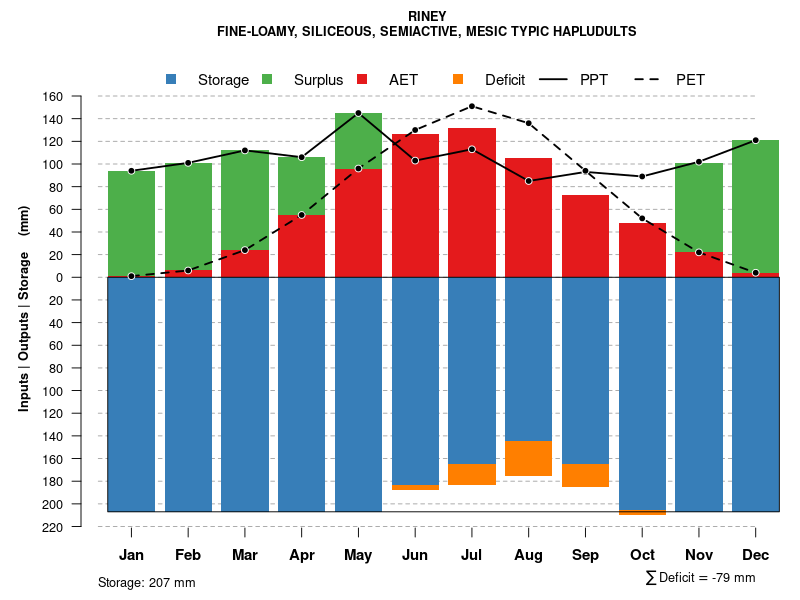| Riney loam, 12 to 35 percent slopes | RmcE | 1224 | 1152450 | 17p6t | in061 | 2007 | 1:12000 |
Riney loam, 6 to 12 percent slopes | RnC | 831 | 1592430 | 1qg1q | ky001 | 2006 | 1:12000 |
Riney loam, 2 to 6 percent slopes | RnB | 51 | 1592429 | 1qg1p | ky001 | 2006 | 1:12000 |
Riney loam, 12 to 20 percent slopes, eroded | ReD2 | 694 | 549075 | 2zs5r | ky047 | 1977 | 1:20000 |
Riney loam, 6 to 12 percent slopes, eroded | ReC2 | 453 | 549074 | 2zs5q | ky047 | 1977 | 1:20000 |
Riney clay loam, 12 to 30 percent slopes, severely eroded | RmE3 | 421 | 549076 | lfc4 | ky047 | 1977 | 1:20000 |
Riney loam, 6 to 12 percent slopes, eroded | ReC2 | 640 | 548720 | 2zs5q | ky141 | 1972 | 1:20000 |
Riney loam, 2 to 6 percent slopes | ReB | 147 | 548719 | 2zs5p | ky141 | 1972 | 1:20000 |
Riney-Christian complex, 20 to 35 percent slopes, eroded | RcE2 | 1110 | 552364 | ljs6 | ky155 | 1986 | 1:20000 |
Riney loam, 6 to 12 percent slopes | RaC | 640 | 552363 | ljs5 | ky155 | 1986 | 1:20000 |
Riney loam, 6 to 12 percent slopes, eroded | ReC2 | 590 | 551176 | 2zs5q | ky219 | 1984 | 1:20000 |
Riney gravelly loam, 12 to 30 percent slopes, severely eroded | RmE3 | 290 | 551178 | lhjy | ky219 | 1984 | 1:20000 |
Riney loam, 12 to 20 percent slopes, eroded | ReD2 | 140 | 551177 | 2zs5r | ky219 | 1984 | 1:20000 |
Riney loam, 6 to 12 percent slopes | RnC | 1773 | 550418 | lgrf | ky605 | 1975 | 1:20000 |
Riney-Lily complex, 12 to 20 percent slopes | ReD | 860 | 549613 | lfxg | ky607 | 1992 | 1:20000 |
Riney loam, 6 to 12 percent slopes, eroded | RaC2 | 824 | 549612 | lfxf | ky607 | 1992 | 1:20000 |
Riney-Lily complex, 20 to 30 percent slopes | ReE | 731 | 549614 | lfxh | ky607 | 1992 | 1:20000 |
Riney loam, 6 to 12 percent slopes | ReC | 5183 | 552575 | lk00 | ky620 | 1979 | 1:20000 |
Riney loam, 12 to 20 percent slopes | ReD | 1418 | 552576 | lk01 | ky620 | 1979 | 1:20000 |
Riney sandy clay loam, 6 to 20 percent slopes, severely eroded | RcD3 | 4830 | 551066 | lhfb | ky621 | 1975 | 1:20000 |
Riney loam, 12 to 20 percent slopes | RbD | 3880 | 551064 | lhf8 | ky621 | 1975 | 1:20000 |
Riney loam, 6 to 12 percent slopes | RbC | 3510 | 551063 | lhf7 | ky621 | 1975 | 1:20000 |
Gullied land (riney) | Gu | 2145 | 551042 | lhdk | ky621 | 1975 | 1:20000 |
Riney loam, 20 to 30 percent slopes | RbE | 1285 | 551065 | lhf9 | ky621 | 1975 | 1:20000 |
Riney-Allegheny complex, 4 to 12 percent slopes | ReC | 900 | 550713 | lh1y | ky623 | 1985 | 1:20000 |
Riney-Ezel complex, 6 to 20 percent slopes | RnD | 357 | 550954 | lh9q | ky641 | 1994 | 1:24000 |
Nolichucky fine sandy loam, 6 to 12 percent slopes, eroded (riney) | NoC2 | 373 | 2453001 | 2nbk2 | ky646 | 1966 | 1:15840 |
Nolichucky fine sandy loam, 2 to 6 percent slopes (riney) | NoB | 312 | 2453000 | 2nbk1 | ky646 | 1966 | 1:15840 |
Riney loam, karst, 12 to 20 percent slopes, eroded | RnD2 | 7215 | 2453099 | 2nbn7 | ky647 | 1989 | 1:20000 |
Riney loam, 12 to 20 percent slopes, eroded | ReD2 | 6661 | 2453102 | 2zs5r | ky647 | 1989 | 1:20000 |
Riney loam, karst, 6 to 12 percent slopes, eroded | RnC2 | 5470 | 2453098 | 2nbn6 | ky647 | 1989 | 1:20000 |
Riney loam, 6 to 12 percent slopes, eroded | ReC2 | 4644 | 2453101 | 2zs5q | ky647 | 1989 | 1:20000 |
Riney loam, karst, 20 to 30 percent slopes | RnE | 3506 | 2453100 | 2nbn8 | ky647 | 1989 | 1:20000 |
Riney loam, karst, 2 to 6 percent slopes | RnB | 450 | 2453097 | 2nbn5 | ky647 | 1989 | 1:20000 |
Riney silt loam, 12 to 20 percent slopes, eroded | ReD2 | 944 | 2379214 | 2kvrv | ky648 | 2009 | 1:12000 |
Riney silt loam, 6 to 12 percent slopes, eroded | ReC2 | 633 | 2379213 | 2kvrt | ky648 | 2009 | 1:12000 |
Riney silt loam, 20 to 30 percent slopes | ReE | 86 | 2379215 | 2kvrw | ky648 | 2009 | 1:12000 |
Riney loam, karst, 2 to 6 percent slopes | RnB | 36 | 2379413 | 2kvz8 | ky648 | 2009 | 1:12000 |
Riney silt loam, 2 to 6 percent slopes, eroded | ReB2 | 27 | 2379212 | 2kvrs | ky648 | 2009 | 1:12000 |
Riney loam, 6 to 12 percent slopes, eroded | ReC2 | 2970 | 2452896 | 2zs5q | ky709 | 1995 | 1:20000 |
Riney loam, 12 to 20 percent slopes, eroded | ReD2 | 1900 | 2452897 | 2zs5r | ky709 | 1995 | 1:20000 |
Riney loam, 2 to 6 percent slopes | ReB | 396 | 2452895 | 2zs5p | ky709 | 1995 | 1:20000 |















